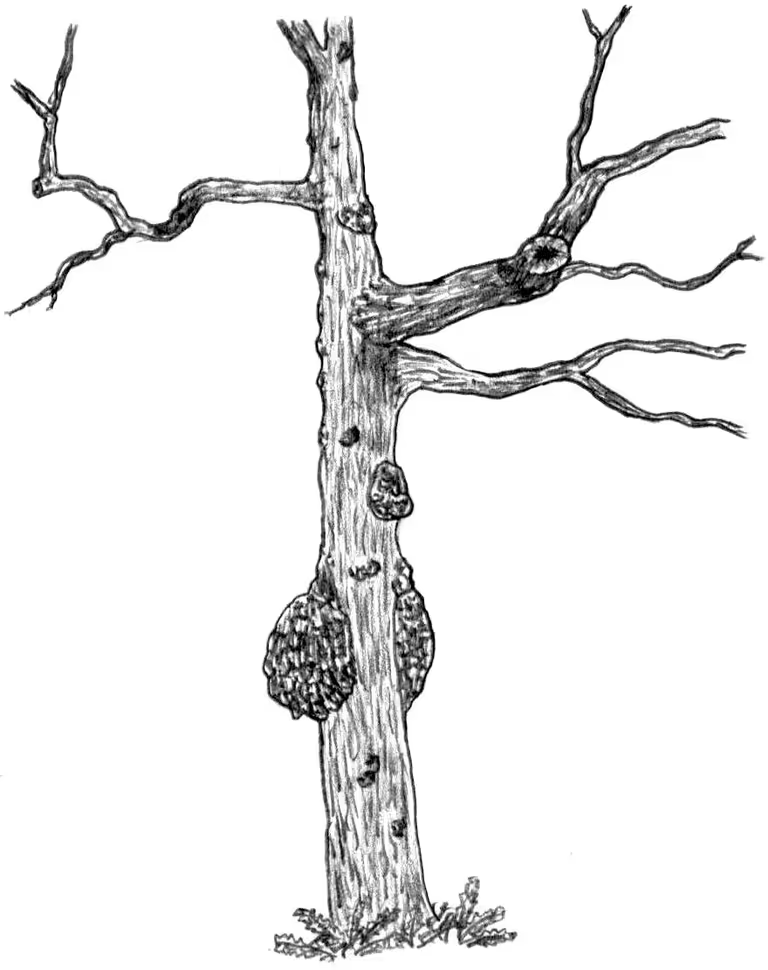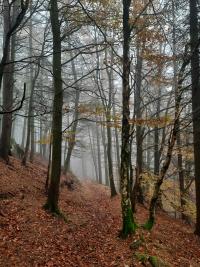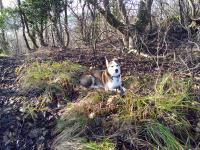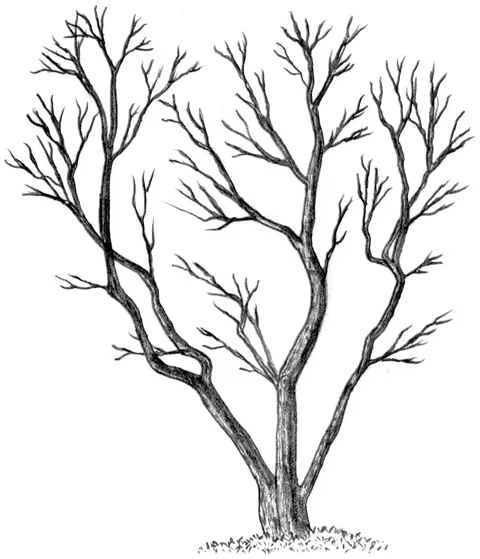The Magic of the Woods
Share this page

‘In the woods too, a man casts off his years, as the snake his slough, and at what period soever of life, is always a child. In the woods, is perpetual youth. Within these plantation of God, a decorum and sanctity reign, a perennial festival is dressed, and the guest sees not how he should tire of them in a thousand years.’ (Ralph Waldo Emerson from ‘Nature’)
Believe it or not the English were once thought of by southern Europeans to be rather whimsical and prone to flights of fancy, such was our belief in fairies, fauns, dryads, nymphs, pixies, goblins, trolls and demons. I’m not sure what happened, but if this sense of magic still resides in us I think it is most likely to be brought out by the woods. It is easy to find yourself wanting to skip when walking through leafy bowers between twisted oak trees or crossing a carpet of bright bluebells. The woods can excite the child in all of us, make us want to spend all day building dens and tree houses, chasing each other with spears or bows and arrows or playing silly hide-and-seek games as we used to before we brought too many thoughts into the wood with us.
I have always thought it easier to imagine a god in the woods than in a stuffy church. The Druids were famous for their veneration of sacred groves, particularly oak, yew and ash, but they were just one of a number of our Celtic and pre-Celtic ancestors for whom trees were hallowed. The Anglo-Saxons also brought with them a German version of tree worship, which existed alongside these Celtic cults until Christianity swept it all aside from the 7th century. This religion of the book, as opposed to the largely undocumented religions that preceded it, may be largely responsible us losing our connection with the magic of the woods, though many of the non-Conformist sects that were particularly popular in West Yorkshire in the 18th and 19th centuries were forced to meet in secret locations in the woods. Our old gods are the sacred trees that are alive with spirits should we wish to find them.

Until surprisingly recently superstitions about many of our most common trees were widely held. The Toothache Tree in Buck Wood near Bradford was used in the early 20th century to transfer the pain of toothache onto the tree by driving nails into its bark. Similarly warts could be passed to an ash tree by rubbing them with bacon and leaving this in the tree, or pricking them with a pin that was then plunged into the tree. Holly, rowan and birch all kept witches at bay, though a witches broom was made of birch. A piece of elder in your pocket helped you sleep and even guarded against adultery, and yet could be possessed by witches. The hawthorn was the fairies’ meeting place and should never be removed from the forest. Willow was a tree of sorrow and prophecy. Ash sap had the power to heal, and ill children passed through a cleft ash would be imbued with the ash tree’s great strength. Alder leaves were used to soothe travellers’ feet and the tree thought to connect to the other world, so permission should be asked of the tree before cutting it. The slow-growing venerated yew was most powerful of all; dark, deadly poisonous and bad luck to chop down or even carry, it transported you to the underworld if you fell asleep beneath it.
Perhaps part of the enduring excitement of the woods is the way light and dark meet there, both literally and metaphorically. It is just as easy to imagine the devil, monsters and ghosts as it is benign forces. In the Middle Ages, large woods were seen as dangerous, impassable, dark and the realm of highwaymen. There is a reason for the enduring appeal of the story of Robin Hood and he perhaps best illustrates our ambivalent relationship with the woods. Woods on the edge of the city or down remote lanes are still likely to be the site of nefarious activities that we’d rather keep away from, particularly at dusk and beyond. There is a reason so many of the best horror films – The Evil Dead, The Blair Witch Project, The Witch, Last House on the Left, Eden Lake, The Cabin in the Woods, Friday the 13th and Antichrist among the finest – are set in the woods because the setting itself forms an integral part of the uneasiness these films inspire. Walking in woods in the mist or as darkness falls, there is always the possibility of something lurking just beyond that tree. I find this particularly true in conifer plantations, where the darkness relentlessness of the trees is so disquieting. Before much of it was felled recently, Rivock Plantation above Keighley was associated with sightings of spectral hooded figures, thought to be the ghosts of miners killed in the nearby pits. Chatterchains, a spectral black dog with rattling chains around its neck, was said to live in the woods under Baildon Bank, and the Gabble Ratchets were a pack of huge hounds with human heads that roamed the woods – around Leeds these were said to represent the souls of unbaptised children.

Researching the West Yorkshire Woods books I have come across numerous school and community projects in the woods of the Aire Valley, where fairy villages have been created with miniature doors, signs and figures pinned to the poor trees, and my first thought has been that this is vandalism. Why are we not teaching our children about the real history of the woods? But, though I would like to see more biodegradable materials used, perhaps I ought to respect it as a way of connecting with an important part of our history and passing on the wonder of the woods to future generations. Countless times I have used the word ‘magical’ to describe my favourite parts of walks in this book, places where I am transported to some primordial or fairytale world, so why shouldn’t we encourage our children to let their imagination run wild in the woods?
I hadn’t picked up on forest bathing until researching this book, but it is now fashionable around the world. In Japan it is known as shinrin yoku, a term created in 1982 by the Minister of Agriculture, Forestry and Fisheries, and doctors regularly prescribe a walk in the woods as therapy for various ailments. In Norwegian tradition it is called skogluft (meaning ‘forest air’) and it is advocated as a means of improving mental health by English journalist Isabel Hardman in her book The Natural Health Service. These ideas have proved particularly important during the Covid-19 pandemic, when all we have as an escape other than Zoom and Netflix is our immediate local landscape, whether this is escaping mental health issues or just incapacitating boredom. In much of West Yorkshire we are fortunate that many of our urban areas have good access to plenty of woodlands and, even in the centre of Leeds, you don’t have to walk too far to reach a landscape of trees.
The effect of trees on us is starting to be better understood, though they remain almost as much of a mystery as the human mind. Some trees, including pine, yew and hornbeam, release antimicrobial chemicals called phytoncides. These contain similar terpenes to those found in CBD and lower our pulse rate and blood pressure and improve our immune system. Sap is not just a pleasant smell, it actively calms us. However, trees only emit these phytoncides when in places they are comfortable growing, and can have an opposite negative chemical effect when they are not – perhaps this is why some plantations have such a disquieting effect on us. The woods also can have an obvious cooling effect on us in the height of summer, when the shade and the moisture stored in mosses keeps the air cool and can be a relief from the hot sun. Trees act as natural air purifiers, not just on the larger scale of making our planet habitable, but locally by absorbing a lot of air pollution, which is important when many of West Yorkshire’s woods are close to urban areas.
Trees are not as passive as we might assume. We tend to see them as helpless victims we need to cosset but, for all we have done to them and their natural environment, they will be here long after us. The complexity of the networks of mycorrhizal fungi that sustain trees is just coming to light. Mycorrhiza literally means ‘fungus root’ and refers to a symbiotic relationship between plant and fungus, with the networks of fungal roots that exist beneath the mushrooms and toadstools of the forest wrapping themselves around the roots of a tree and in some cases working deep into them. A single mycorrhizal organism can cover many hectares and connect all the trees in a large wood, providing a co-dependency without which species like the beech cannot survive. The fungi feeds on sugars that the tree produces by photosynthesis, and in return breaks down the leaf and wood matter on the forest floor to make nutrients available to the trees. Its filaments also allow the trees to communicate with each other about weather, insect infestations and imminent danger, as well as share nutrients and water to sustain those that are in poor health. Each species has its own mycorrhizal network and its ability to colonise a new area is often dependent upon these developing sufficiently. In fact the oak acorn’s inability to germinate in woods, relying instead on the forgetful jay to bury them elsewhere, is thought to be the result of a quirk in its mycorrhizal fungi. The vibrations that trees emit through these networks can be felt by us, whether we are aware of it or not. I think it is awe-inspiring to lie on the ground in the wood and imagine the activity going on beneath me, to think that the trees can sense us and are communicating about us that very moment. Trees have adapted to us far more adeptly than we have to them – for example trees closer to roads have thicker bark to account for the subtle pulsation of passing traffic – but we are not even trying to listen back.

Trees are one of our best memories of time – they can live through many generations, surviving the pollution and climate change that we are apparently insensitive to – and it is all there etched in their rings, which contain dead wood from each year of a tree’s life. It’s not that trees don’t operate on our timescale, it’s that we don’t operate on theirs. Perhaps getting closer to trees can help us to become a little more like them.
